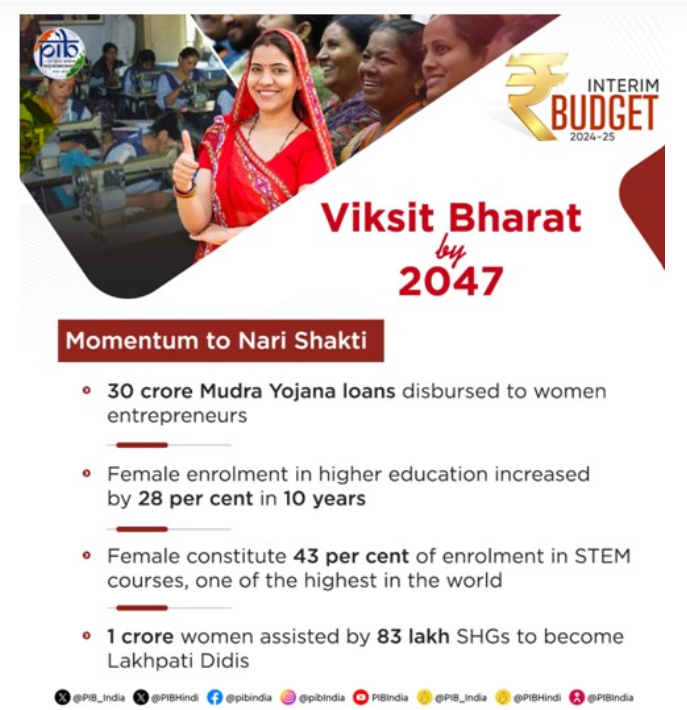GIST OF KURUSHETRA – Enhancing Innovation in Rural India
Chapter 1- Making Lakhpati Didis
Lakhpati Didi Initiative:
- It is an initiative of the Ministry of Rural Development that strives to empower women associated with Self-Help Groups (SHG) to have an annual household income exceeding Rs. 1,00,000 through adopting sustainable livelihood practices.
- It was launched in 2023. With an initial target det for 2 crore Lakhpati Didis, the program target has been enhanced to 3 crores during 2024-25.
Overview of the Initiative:
- The Lakhpati Didi initiative supports over 94 lakh Self-Help Groups (SHGs) with 10 crore women, empowering them to achieve an annual household income exceeding Rs. 1,00,000.
- These women inspire others through sustainable livelihood practices and achieving a decent standard of life.
- SHGs provide support through collective action, financial literacy, and skill development for entrepreneurial ventures.
- The initiative facilitates diverse livelihood activities by coordinating across Government departments, Panchayati Raj Institutions, Private sector, and Market players with focused planning, implementation, and monitoring at all levels.
Strategy of the Scheme:
- Deepen, Strengthen, and Expand Livelihood Options: Households will be facilitated in diversifying income-generating activities. Trained Community Resource Persons will use a tool for Livelihood Planning and upload data to a digital platform for consolidation and resource linkages.
- Capacity Building: A Cascade Training Strategy will be used to train and support Potential Lakhpati Didis (SHG members) across India. Experts will train Resource Persons, who will then train Master Trainers in each state and union territory. These Master Trainers will train Community Resource Persons selected by State Missions to guide the identified Lakhpati Didis.
- Financial Assistance: DAY-NRLM will help mobilize financial support for SHG women and their federations, providing a platform for their growth.
- Aajeevika Register: SHG members are involved in diverse livelihood activities like agriculture, livestock rearing, handicrafts, and more. The Aajeevika Register tracks these activities at the village level to enhance income and measure progress. Maintained at the Village Organization (VO) level, it will be updated every six months to aid planning and track the progress of Lakhpati Didis.
Financial Assistance:
- Revolving Fund (RF): A savings fund within a Self Help Group (SHG) where members contribute regularly and lend to each other for urgent needs, fostering ownership and financial habits. Each SHG typically receives Rs. 20,000 to Rs. 30,000 for internal lending.
- Vulnerability Reduction Fund (VRF): Provided to Village Organisations (VOs) via Cluster Level Federations to address vulnerabilities like food insecurity and health risks. Each VO gets Rs. 1,50,000 for member livelihoods and collective activities, disbursed based on Micro Credit Plans (MCPs) and Vulnerability Reduction plans.
- Community Investment Fund (CIF): Enhances the creditworthiness of community institutions and empowers women in financial management. SHG federations lend up to Rs. 2.50 lakh per SHG for various socio-economic activities, distributed through Cluster Level Federations or Village Organizations.
- Viability Gap Fund (VGF): Supports Cluster Level Federations (CLFs) in covering operational costs until they achieve 100% Operational Self-Sufficiency. Provides financial assistance for three years to help CLFs reach financial sustainability.
- Financial Inclusion: Engages SHG members with financial regulators and commercial banks through workshops, forums, and capacity-building programs to empower them as financially established individuals, referred to as “Lakhpati Didis”.
- Women Producer Groups (PGs) can receive financial support of Rs. 2 Lakh per group for working capital and infrastructure, enabling them to aggregate commodities and achieve better price negotiation and higher profits in the market. This support aims to sustain and enhance the business activities of these small-sized, unregistered entities at the village level.
- Producer Enterprises (PEs): Promote large Producer Enterprises for economies of scale, better market access, and professional management. State-level federations are encouraged.
- Women Farmer Producer Organizations (FPOs): Partnering with the Ministry of Agriculture, Rs. 15 lakh equity grants are provided over three years to each FPO.
- Community Enterprise Fund (CEF): Schemes like SVEP and OSF support SHG members in developing and expanding enterprises. SVEP has a budget of Rs. 6.5 crore per block, creating Block Resource Centers and placing Community Resource Persons for assistance.
- Aajeevika Grameen Express Yojana (AGEY): Provides subsidized loans for rural transport services. Individuals can get loans up to Rs. 6.5 lakhs, and groups up to Rs. 8.5 lakhs.
- One Stop Facility (OSF): Block-level centers provide business development services. Support is Rs. 2.5 lakh for individual enterprises and Rs. 5 lakh for group enterprises with a 10% entrepreneur contribution.
- Micro Enterprise Development (MED): Supports non-farm sector enterprises for SHGs with a Rs. 20 lakh budget per block, aiding at least 200 enterprises.
- Incubator:Aims to scale up 150 women-owned enterprises in each state/UT with Rs. 10.70 crore per state for manufacturing and service sectors.
- Cluster Promotion: Promotes artisan and sectoral clusters with Rs. 5 crore per cluster for interventions like design development, market development, and technology upgradation.
- Capitalization Support for SHGs: Includes collateral-free loans up to Rs. 20 lakh per SHG, interest subvention, overdraft limits, and the Women Enterprise Acceleration Fund for credit guarantees and loans.
- Marketing Support: Market linkages through buyer-seller meets, e-commerce platforms (e.g., Amazon, Flipkart, Meesho), and partnerships like Patanjali for SHG products.
